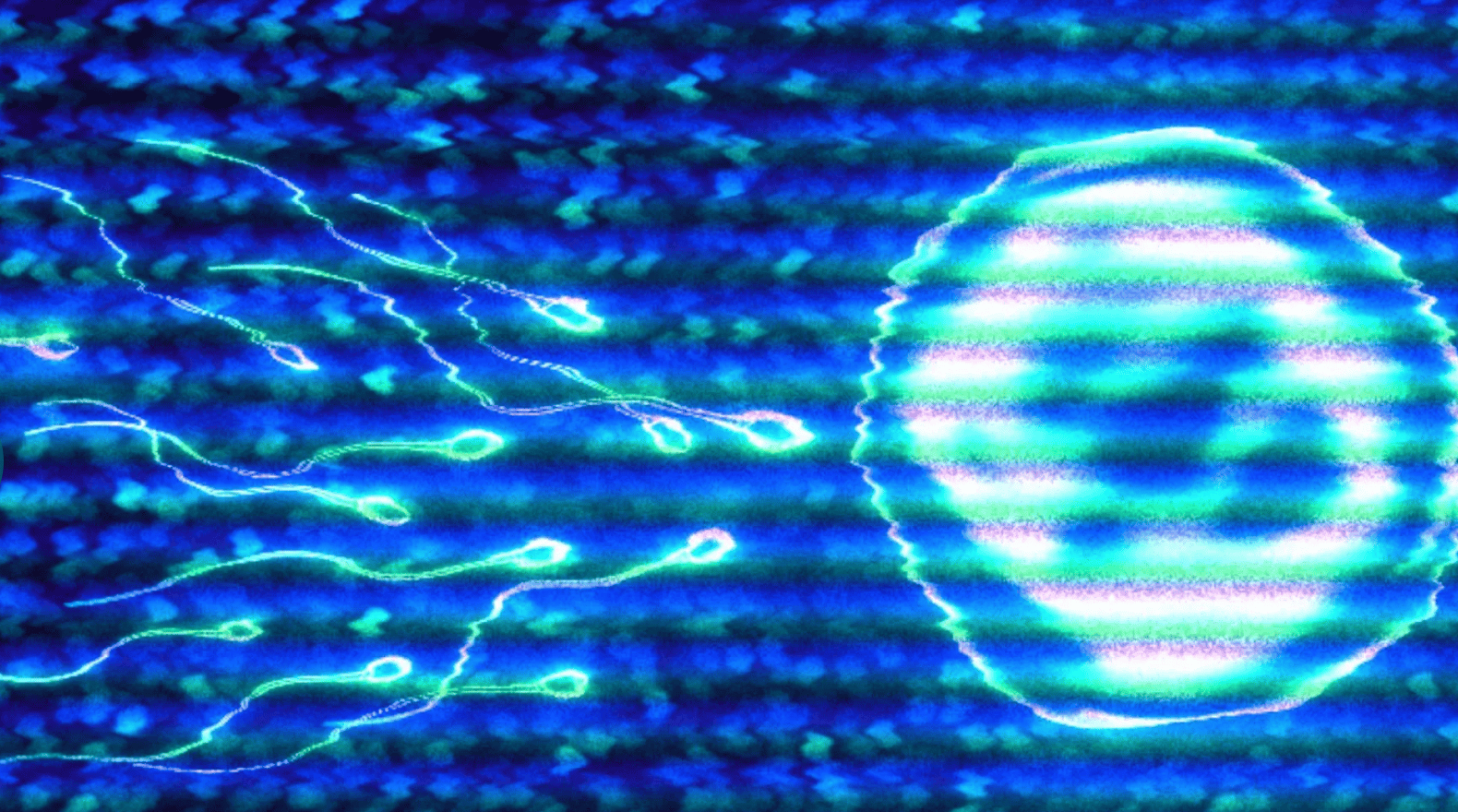A recent bombshell study found that sperm counts are plummeting faster than we thought. What is driving this trend, and can we reverse it?
Staring at negative pregnancy tests, enduring the rollercoaster of fertility treatments and the heartbreak of miscarriages: struggling to conceive a child can be extremely stressful.
So, when an international team of scientists published alarming research showing that sperm counts had more than halved worldwide in the past 50 years and that the trend was accelerating, naturally it sparked concern.
The decline, they warned, could become a problem too big to ignore, with the potential to “threaten mankind’s survival”.
Professors Hagai Levine and Shanna Swan, who have been studying reproductive health for decades and published these latest findings, drew parallels with the climate crisis.
They told Euronews Next how first, there was denial. Eventually, we recognised there was a problem. And only then did we accept to take responsibility and try to turn things around.
So, how worried should we be about sperm counts? What do sperm counts actually mean for male fertility? What is driving this decline? And importantly, what can we do about it?
Fertility is complex and multi-faceted, and none of these questions has clear-cut answers. But let’s walk you through what we know about the collective state of men’s reproductive health.
Why do sperm counts matter?
Sperm count is important, but it isn’t everything. When a man goes for a fertility checkup and gets a semen analysis done, three key parameters are looked at: sperm count, but also sperm motility and sperm morphology.
Sperm counts are simply easier to consistently track. Semen analysis techniques have evolved over the years, but counting sperm has mostly relied on a fairly simple device called a haemocytometer. In their meta-analysis of research on sperm counts since 1973, Levine and Swan’s team only selected studies – 223 of them – that used this method.
They noted that while sperm counts are “an imperfect proxy for fertility,” they’re closely linked to fertility chances.
An abnormally low sperm count, also called oligospermia, is when a man has fewer than 15 million sperm per millilitre of semen.
But Levine and Swan’s team note that research suggests below a threshold of 40-50 million/ml – the global average currently sits at around 49 million/ml – the probability of conception rapidly declines, meaning couples are likely to have to wait longer to have a baby.
“In my opinion, there is absolutely no question that human male reproductive health has changed for the worse over the past 70+ years, and is a real concern going forwards in terms of its negative impact on couple fertility potential,” Professor Richard Sharpe, of the University of Edinburgh’s Centre for Reproductive Health, told Euronews Next.
Reproductive experts also stress that sperm counts are a useful indicator of overall health.
Men with low sperm counts tend to live shorter lives and are more likely to have cancer, diabetes and cardiovascular disease than more fertile men.
“The ability to produce testosterone and sperm is highly dependent on your overall health, and it’s one of the things that’s most vulnerable in a man,” said Professor Bradley Anawalt, a male reproductive endocrinologist at the University of Washington School of Medicine.
Are chemicals to blame for falling sperm counts?
While their study did not explore the causes of the sperm count drop, Levine and Swan point to the role of lifestyles and the manmade chemicals that are ubiquitous in our modern world.
After all, much of the food we eat and the everyday products we use are packaged in plastics – from our cosmetics and cleaning products to our microwaveable popcorn and takeaway meals. The chemicals from these plastics leach into our food, our environment, and our bodies.
Research shows chemicals such as phthalates, which have long been used to make plastics soft and flexible, and bisphenol A (BPA), which is used in hard plastic bottles, can disrupt humans’ hormonal and reproductive systems, especially in their earliest stages of development, inside the expectant mother’s womb.
“If you mess with the hormones you need to have a functioning reproductive system, you’re not going to have a functioning reproductive system,” Swan told Euronews Next.
Swan delved into the topic in a book, Count Down, and has been sounding the alarm across mainstream media – as well as on Joe Rogan’s podcast.
Her book outlines how chemical pollution is harming fertility and leading to more babies (and animals) being born with reproductive disorders and smaller penises.
Taint length matters for fertility
Research suggests chemicals such as phthalates can affect one of the most significant differentiators of a person’s sex: the measurement between the anus and the scrotum, known as anogenital distance (AGD) – or, more commonly, as gooch or taint.
A male’s AGD is typically twice the length of a female’s AGD, but it can be shorter if testosterone production is impaired during the first trimester of pregnancy, when the release of this hormone is key for a genetically male embryo to develop testicles and a penis.
“If the testosterone is not there at the right time and there isn’t enough of it, then that process of differentiation doesn’t happen or isn’t complete,” Swan explained.
In a study carried out on students in New York a decade ago, Swan found that men with an AGD below the 5 cm median were seven times more likely to have a low sperm count putting them in the “subfertile” category.
It also makes them more likely to have undescended testicles and a smaller penis.
Other chemicals are also suspected to interfere with the early development of testicles. A recent study on 864 Danish young men found that those who were exposed in utero to higher levels of “forever chemicals” known as PFAS consistently had lower sperm counts and a higher proportion of immotile sperm in adulthood.
However, some experts say more research is needed to pinpoint what is actually disrupting testosterone production in the critical time window of genital development in early pregnancy.
Sharpe said he started suspecting environmental chemicals 30 years ago, but he’s now increasingly suspecting that exposure to more active pharmaceutical drugs such as paracetamol may be to blame.
“Nearly all pregnant women take one or more such drugs during pregnancy, with paracetamol (acetaminophen) top of that list,” he said.
“The evidence we have, from several groups, is that exposure of the human foetal testis to human therapeutic levels of paracetamol is sufficient to impair testosterone production”.
Anawalt, who’s been sceptical of the “spermageddon” thesis, still says it’s fair game to zero in on the role played by chemicals and medications.
“I think it’s important for all of us to ask the question: what does it mean to have all of our prescription drugs flushed down the toilet and to join the water supply of the world?”
What about our lifestyles?
It’s difficult to overlook the fact that the past 50 years – the period over which sperm counts have halved – have seen major changes in how we live that haven’t been good for fertility.
Scientists suspect expanding waistlines, sedentary lifestyles, stress, and alcohol and drug use are likely all playing a role.
“During that time, we’ve had what has been described probably appropriately as an epidemic of weight gain and obesity,” Anawalt stressed.
“And we do know that with increasing body weight and obesity, there are declines in serum testosterone and there appear to be declines in fertility and sperm concentration”.
Obesity is also linked to type 2 diabetes, which increases the risk of erectile dysfunction.
In a recent Danish study, obese men who followed an eight-week low-calorie diet and lost on average 16.5 kg saw a 40 per cent improvement in their sperm count.
This boost was sustained for a whole year in men who maintained the weight loss, but not in those who regained weight.
So, the good news is some of the damage is reversible, provided we take action.
What can we do to protect our fertility?
“It may sound boring and hackneyed, but eating a balanced diet with lots of fresh veg and fruit, and low amounts of processed food, is by far the best thing that people can do,” Sharpe said.
The added benefit of doing that is that it will also lower your exposure to manmade chemicals such as phthalates or BPA, which tend to get into processed and pre-packaged foods, he noted.
Try to exercise, maintain a healthy weight and don’t smoke. Smoking is strongly associated with infertility.
“Whatever your doctor tells you to do to help you care for your heart is going to help your fertility,” Swan advised.
While recognising not everybody has the resources to do that, she recommends eating organic food and using glass – not plastic – containers to store, freeze and heat meals.
Among other tips to avoid exposure to chemicals: minimise the number of personal care products you use; avoid fragrances – whether in laundry, soap or plug-ins and air fresheners – as they often contain phthalates; take off your shoes when you get into your house to leave the dust at the entrance; vacuum with a high-efficiency particulate air (HEPA) filter; and filter your drinking water if you suspect it might contain chemicals or microplastics.
Steer clear of the hot tub, sauna or steam room before trying to conceive, as the heat will lower your sperm count. Similarly, you might already know it’s best to also avoid tight underwear, as testicles hang outside of the body for good reason: they need to be kept cool.
And importantly: have sex! Anawalt advises a reasonable target is once or twice a week, especially around the time of ovulation.
While modern couples may have busy schedules and expect that things will happen when they plan for it, it’s important to find the time to stay healthy, consult a doctor if in doubt, and overall be patient.
“Sometimes you just need to give it a little time,” Anawalt said.
From euronews.com
Disclaimer: We at Prepare for Change (PFC) bring you information that is not offered by the mainstream news, and therefore may seem controversial. The opinions, views, statements, and/or information we present are not necessarily promoted, endorsed, espoused, or agreed to by Prepare for Change, its leadership Council, members, those who work with PFC, or those who read its content. However, they are hopefully provocative. Please use discernment! Use logical thinking, your own intuition and your own connection with Source, Spirit and Natural Laws to help you determine what is true and what is not. By sharing information and seeding dialogue, it is our goal to raise consciousness and awareness of higher truths to free us from enslavement of the matrix in this material realm.
 EN
EN FR
FR



























And most important of all is the elephant in the room. Stop taking any kind of vaccine. They have never saved a single life since their invention.
What can we do to protect our fertility? Biggest killer is the cell phone radiations, making all animal life and insect life sterile. Hurting and killing many plants as well. Documented over decades, as in half a century it has been well known but suppressed, least profits suffer. Educate yourself;
The Invisible Rainbow by Arthur Firstenberg (free PDF)
https://archive.org/details/the-invisible-rainbow
How does the ever growing artificial radiation, especially 5G, affect the human body and fertility, although it has been raised to a million times higher than natural radiation since the early 1900s?
What about the chemtrails sprayed over us on a daily basis? Howcome no mainstream scientist is studying THAT?
Because if they were, they should admit that the weather anomalies sold as "climate crisis" and the infertility problems can be traced back to the same source: systematic geoengineering by chemicals, radiation, etc.?
It is not just his one thing. Yet a encyclopedia of all poisons inoculated upon all man kind. The daily numbers of Victims we see not read the paper maybe odd obituary. Yet to us great loss of Cousin thing etc. They see it as a climbing victory to eliminating mankind 1 by 1 or many of nation, using their Eugenics tricks to slow human reproduction and end the rest by murder death kill. Shame we did not see into this now time frame to then have properly taken corrective matters upon first notice of its leaking in start.
Yet too not even the water food air mind visual audible sub sonic radiated, poisons submitted to our daily every breath and mouthful swallow and indigestive case continues. Someone has been doing this a very out of mind thought time to age sinister plan ago and the now is not too late to. But its now of the whom to will make that. Proper climatic and immediate stop of all practice in crimes against all humanity.
The major cause of infertility is ignored (some reports kept secret since 1970 least you learn the truth) and no one dares touch the most holy of holies, the cell phone. Multiple suppressed research shows animals going sterile from cell phone radiation. Killing our insects, plants, and animals. Oh but the convenience! To hell with all planetary life if it interferes with your ephemeral convenience. Research also shows the graphene in your blood is activated by cell phone radiations. Building antennas inside your DNA compromised vaxxed hybrid, as in no longer human.
The Invisible Rainbow by Arthur Firstenberg (free PDF)
https://archive.org/details/the-invisible-rainbow